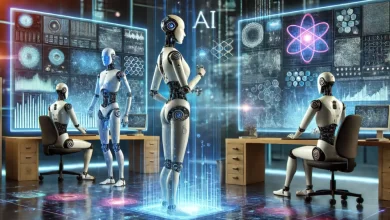Generative AI Blueprints: Redefining the Future of Architecture

The future of architecture is no longer limited to traditional blueprints and design tools. Generative AI is redefining the way we conceptualize and build spaces, providing new tools to simplify complex designs, explore innovative possibilities, and optimize for sustainability. As generative AI-driven blueprints become more integrated into the design process, the future of architecture is evolving in ways we are only beginning to understand. In this article, we take a closer look at how generative AI is quietly shaping the future of architectural design.
Streamline design processes
Designing architecture is a complex process that requires a careful balance between structural integrity, energy efficiency and aesthetics, and requires both time and thoughtful consideration. Generative AI simplifies this process by relieving architects and designers of time-consuming tasks. It quickly generates multiple design options based on specific parameters, something that would take human designers much longer. This efficiency allows for more thoughtful evaluation of designs, taking into account factors such as durability and structural integrity. Various tools such as Autodesk’s generative design, Grasshopper for rhinoAnd Houdini were developed to facilitate the exploration of design possibilities using generative AI. Text-to-CAD (shortly before Computer aided design) is an emerging area of generative AI, which deals with transforming written directions into 3D models. By pairing specific geometries with descriptive words, these AI systems generate different shapes and styles, leading to downloadable CAD models with editable surfaces that can be used in most CAD programs. With innovative tools such as those from Google Dream FusionOpenAIs Point-ENvidias Magic3Dand that of Autodesk CLIP ForgeGenerative AI accelerates architectural design across industries, empowering architects and designers to simplify complex tasks.
Improving creativity
Generative AI not only streamlines design processes, but also significantly enhances human creativity. Leading companies such as Zaha Hadid Architects use this technology to visualize structures, allowing them to quickly assess different sustainability and aesthetic options. Generative AI can quickly generate countless design iterations, helping architects find and refine the best ideas for their projects. Furthermore, the integration of generative AI into standard CAD tools allows architects to automate routine tasks such as creating compliance reports and managing schedules. This automation frees up their valuable time to focus on the more complex and creative aspects of their work, increasing their productivity and innovation. The potential of generative AI to increase productivity and drive innovation is a source of inspiration for architects and designers, motivating them to push the boundaries of their creativity.
Digital twins and predictive modeling
One of the standout features of generative AI is its ability to create digital twins: virtual models of physical structures that simulate real-world behavior. These models provide a dynamic example of how a structure will perform under different conditions, from environmental stress to structural loads. By subjecting digital twins to detailed stress tests before construction begins, potential problems can be identified and resolved early in the design phase. This predictive modeling minimizes the chance of unexpected problems and significantly reduces the chance of costly adjustments during or after construction. Anticipating and mitigating challenges before they arise ensures more informed decision-making and smoother project execution.
Sustainability and energy efficiency
With increasing emphasis on sustainability, generative AI is becoming increasingly important in improving building performance. By integrating energy efficiency and environmental considerations into the design process, AI helps architects and engineers choose materials and designs that reduce a building’s impact on the environment. This aligns with global sustainability goals and improves the long-term viability of construction projects. AI can recommend energy-efficient systems and environmentally friendly materials, reducing waste and resource consumption. By paying attention to sustainability early in the design phase, buildings can become greener and more cost-effective. As AI continues to develop, its influence on sustainable construction will only increase, leading to more responsible and efficient practices.
Challenges and future directions
While generative AI offers exciting possibilities for architecture and civil engineering, it also brings challenges. The technology can simplify and speed up the design process, but it can also add layers of complexity that may be difficult to manage. Ensuring that AI-generated designs meet customer needs, safety standards and practical requirements requires constant monitoring. Companies are faced with deciding whether to develop custom AI systems tailored to their design philosophies, or rely on generic, off-the-shelf solutions that can provide a different level of detail or specificity. As AI takes on more responsibility in design, there is also a growing need for clear ethical guidelines, especially around intellectual property and liability. Addressing these challenges will be essential for responsible use of AI in the field.
Looking ahead, generative AI has the potential to redefine the blueprints of architecture and engineering, but requires careful integration into existing practices. Advances in AI algorithms can enable generative AI to create advanced and accurate designs, increasing creativity while maintaining functionality. However, careful planning will be required to manage the complexity of data processing and to establish industry standards. Clear regulatory and ethical frameworks will also be essential to address concerns around intellectual property and responsibility. By addressing these challenges, the industry can realize the full potential of generative AI, while maintaining the practical and ethical standards of architectural and engineering design.
Conclusion
Generative AI is redefining architectural blueprints, providing tools that simplify complex designs, increase creativity, and prioritize sustainability. AI is reshaping the way spaces are conceived and built, from streamlining design processes to creating digital twins and improving energy efficiency. However, its adoption also comes with challenges such as managing complexity, ensuring ethical practices and tailoring AI-generated designs to customer needs. As the technology evolves, it holds great promise for the future of architecture, but thoughtful integration and explicit guidelines will be essential to responsibly realize its full potential.






